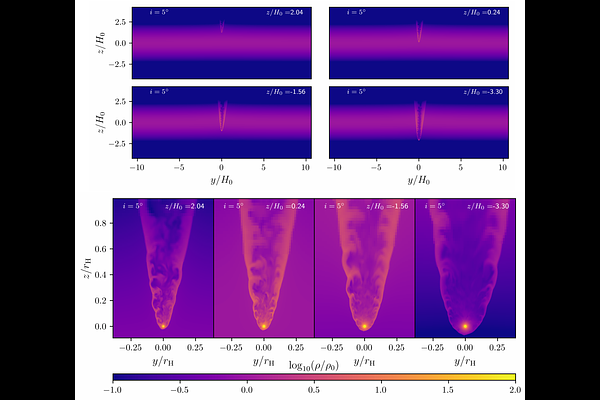Hydrodynamic simulations of black hole evolution in AGN discs I: orbital alignment of highly inclined satellites

Hydrodynamic simulations of black hole evolution in AGN discs I: orbital alignment of highly inclined satellites
Connar Rowan, Henry Whitehead, Gaia Fabj, Philip Kirkeberg, Martin E. Pessah, Bence Kocsis
AbstractThe frequency of compact object interactions in AGN discs is naturally tied to the number of objects embedded within it. We investigate the evolution of black holes in the nuclear stellar cluster on inclined orbits to the AGN disc by performing adiabatic hydrodynamical simulations of isolated black hole disc crossings over a range of disc densities and inclinations $i\in[2^\circ,15^\circ]$. We find radiation dominates the pressure in the wake that forms around the BH across the full inclination and disc density range. We identify no well defined steady state wake morphology due to the thin geometry of the disc and the vertical exponential density drop off, where the wake morphology depends on the vertical depth of the transit within the disc. The inclination damping $\Delta i$ relative the pre-transit inclination behaves as a power law in $\sin(i)$ and the ambient Hill mass $m_\text{H,0}$ as $\Delta i/i \propto m_{\rm H,0}^{0.4} \sin(i)^{-2.7}$. The drag on the BH is dominated by the gravity of the wake for the majority of our inclination range until accretion effects become comparable at $\sin(i)\gtrsim30H_0/R_0$, where $H_0/R_0$ is the disc aspect ratio. At low inclinations ($\sin(i)\lesssim3H_0/R_0$) the wake morphology becomes more spherical, leading to a regime change in the inclination damping behaviour. Our results suggest that the inclination damping timescale is shorter than expected from only episodic Bondi-Hoyle-Lyttelton accretion events during each transit, implying inclined objects may captured by the AGN disc earlier in its lifetime than previously thought.